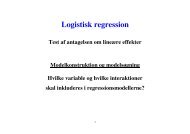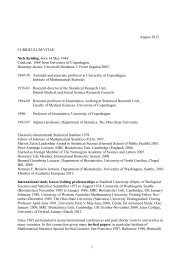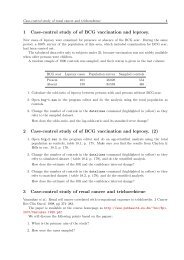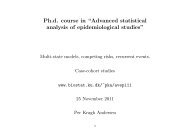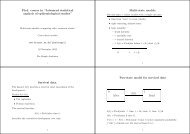Demography and epidemiology: Practical use of the Lexis diagram ...
Demography and epidemiology: Practical use of the Lexis diagram ...
Demography and epidemiology: Practical use of the Lexis diagram ...
Create successful ePaper yourself
Turn your PDF publications into a flip-book with our unique Google optimized e-Paper software.
6 Estimation <strong>of</strong> survival function<br />
St<strong>and</strong>ard prediction machinery can be <strong>use</strong>d to produce estimates <strong>of</strong> log-rates with<br />
st<strong>and</strong>ard errors for a set <strong>of</strong> values <strong>of</strong> t (<strong>and</strong> hence w), <strong>and</strong> some chosen values <strong>of</strong> <strong>the</strong><br />
variables in x. This is a st<strong>and</strong>ard tool in any statistical package for analysis <strong>of</strong><br />
generalized linear models. Rate estimates with. c.i.s are <strong>the</strong>n derived by taking <strong>the</strong><br />
exponential function <strong>of</strong> <strong>the</strong> estimates for <strong>the</strong> log-rates with confidence intervals.<br />
Estimation <strong>of</strong> survival function<br />
The survival function is connected to <strong>the</strong> rate function λ(t) by:<br />
� � t �<br />
S(t) = exp − λ(s) ds<br />
In order to estimate this from a parametric model we need to derive <strong>the</strong> integral, i.e. a<br />
cumulative sum <strong>of</strong> predictions. If we want st<strong>and</strong>ard errors for this we must have not<br />
only st<strong>and</strong>ard errors for <strong>the</strong> λs, but <strong>the</strong> entire <strong>the</strong> variance-covariance matrix <strong>of</strong><br />
estimated values <strong>of</strong> λ.<br />
From a generalized linear model we can easily extract estimates for log � λ(t) � at any<br />
set <strong>of</strong> points. This is just a linear function <strong>of</strong> <strong>the</strong> parameters, <strong>and</strong> so <strong>the</strong><br />
variance-covariance matrix <strong>of</strong> <strong>the</strong>se can be computed from <strong>the</strong> variance-covariance<br />
matrix <strong>of</strong> <strong>the</strong> parameters.<br />
A Taylor approximation <strong>of</strong> <strong>the</strong> variance-covariance matrix for λ(t) can be obtained<br />
from this by using <strong>the</strong> derivative <strong>of</strong> <strong>the</strong> function that maps log(λ(t)) to λ(t). This is <strong>the</strong><br />
coordinate-wise exponential function, so <strong>the</strong> matrix required is <strong>the</strong> diagonal matrix with<br />
entries λ(t).<br />
Finally <strong>the</strong> cumulative sum is obtained by multiplying with a matrix with 1s on <strong>and</strong><br />
below <strong>the</strong> diagonal, so this matrix just needs to be pre <strong>and</strong> post-multiplied in order to<br />
produce <strong>the</strong> variance-covariance <strong>of</strong> <strong>the</strong> cumulative hazard at <strong>the</strong> prespecified points.<br />
In technical terms, let ˆ f(ti) be estimates for <strong>the</strong> log-rates for a certain set <strong>of</strong><br />
covariate values (x) at points ti, i = 1, . . . , I, derived by:<br />
0<br />
ˆf(ti) = B ˆ β<br />
where β = (τ, γ) is <strong>the</strong> parameter vector in <strong>the</strong> model, including <strong>the</strong> parameters that<br />
describe <strong>the</strong> baseline hazard. Let <strong>the</strong> estimated variance-covariance matrix <strong>of</strong> ˆ β be ˆ Σ.<br />
Then <strong>the</strong> variance-covariance <strong>of</strong> ˆ f(ti) is BΣB ′ . The transformation to <strong>the</strong> rates is<br />
<strong>the</strong> coordinate wise exponential function so <strong>the</strong> derivative <strong>of</strong> this is <strong>the</strong> diagonal matrix<br />
with entries exp � ˆ f(ti) � , so <strong>the</strong> variance-covariance matrix <strong>of</strong> <strong>the</strong> rates at <strong>the</strong> points ti is<br />
(by <strong>the</strong> δ-method):<br />
diag(e ˆ f(ti) ) B ˆ Σ B ′ diag(e ˆ f(ti) ) ′<br />
Finally, <strong>the</strong> transformation to <strong>the</strong> cumulative hazard (assuming that all intervals have<br />
length ℓ) is by a matrix <strong>of</strong> <strong>the</strong> form<br />
⎛<br />
1<br />
⎜ 1<br />
L = ℓ × ⎜ 1<br />
⎝ 1<br />
0<br />
1<br />
1<br />
1<br />
0<br />
0<br />
1<br />
1<br />
0<br />
0<br />
0<br />
1<br />
⎞<br />
0<br />
0 ⎟<br />
0 ⎟<br />
0 ⎠<br />
1 1 1 1 1



